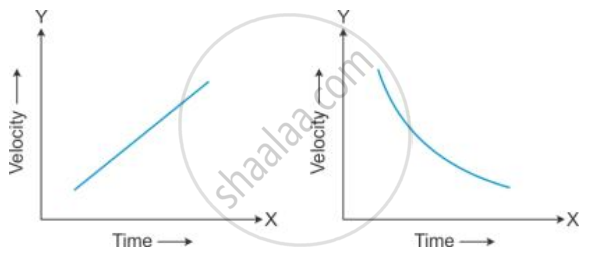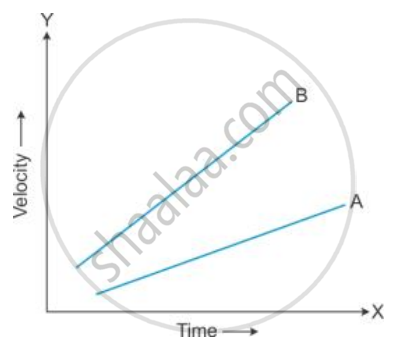Advertisements
Advertisements
प्रश्न
The rate of change of velocity is ______.
उत्तर
The rate of change of velocity is acceleration.
APPEARS IN
संबंधित प्रश्न
Define acceleration. State its unit.
A toy car initially moving with uniform velocity of 18 km h-1 comes to a stop in 2 s. Find the retardation of the car in S.I. units.
State the type of motion represented by the following sketches in Figures.

Give an example of each type of motion.
Figure shows the velocity-time graphs for two cars A and B moving in the same direction. Which car has greater acceleration? Give reasons to your answer.

A body falls freely from a certain height. Show graphically the relation between the distance fallen and square of time. How will you determine g from this graph?
A train moving with a velocity of 20 m s-1 is brought to rest by applying brakes in 5 s. Calculate the retardation.
A car travels with uniform velocity of 25 m s-1 for 5 s. The brakes are then applied and the car is uniformly retarded and comes to rest in further 10 s. Find:
- The distance which the car travels before the brakes are applied,
- Retardation and
- The distance travelled by car after applying the brakes.
A ball is rolling from A to D on a flat and smooth surface. Its speed is 2 cm/s. On reaching B, it was pushed continuously up to C. On reaching D from C, its speed had become 4 cm/s. It took 2 seconds for it to go from B to C. What is the acceleration of the ball as it goes from B to C?

Draw velocity – time graph for the following situation:
When a body is moving with variable velocity, but uniform retardation.
Diagram is given below shows velocity – time graph of car P and Q, starting from the same place and in the same direction. Calculate the Acceleration of car P.

Write the SI unit of acceleration and retardation.
State if the following situation is possible:
A body moving with a constant velocity in an accelerated motion.
What do you mean by constant acceleration?
Negative acceleration is called ______.
The slope of a velocity-time graph gives ______.
The acceleration of the body that moves with a uniform velocity will be ______.
Acceleration is defined as the rate of change of ______.
Assertion: A positive acceleration of a body can be associated with the slowing down of the body.
Reason: Acceleration is a vector.
